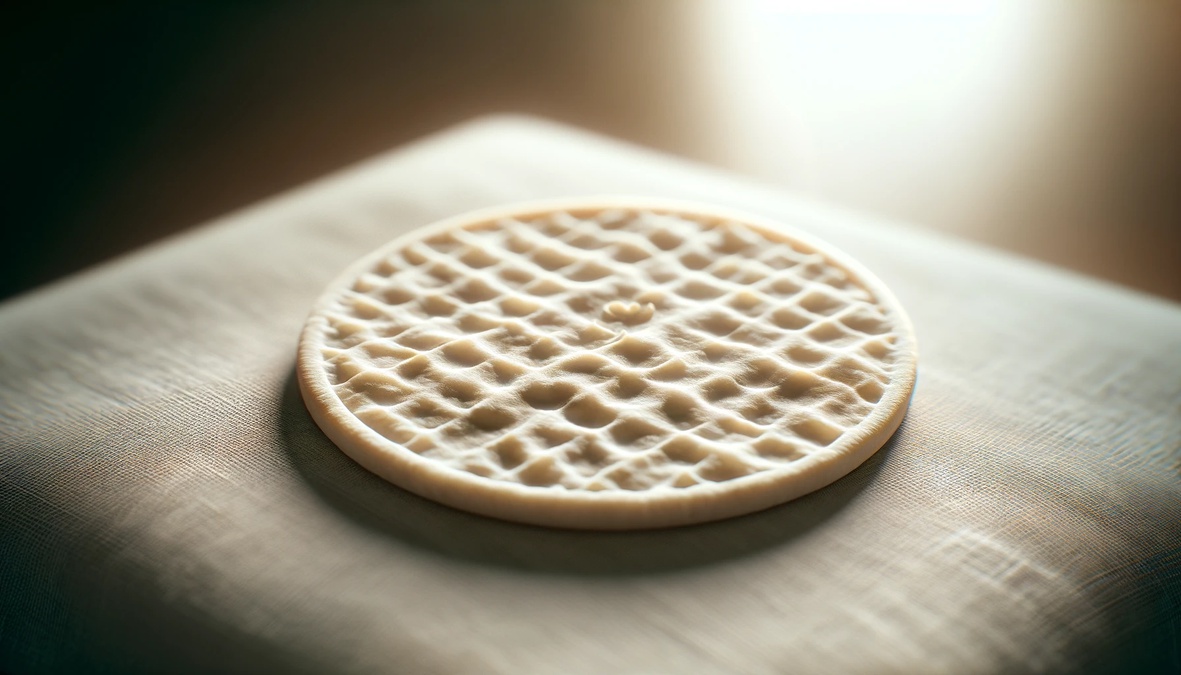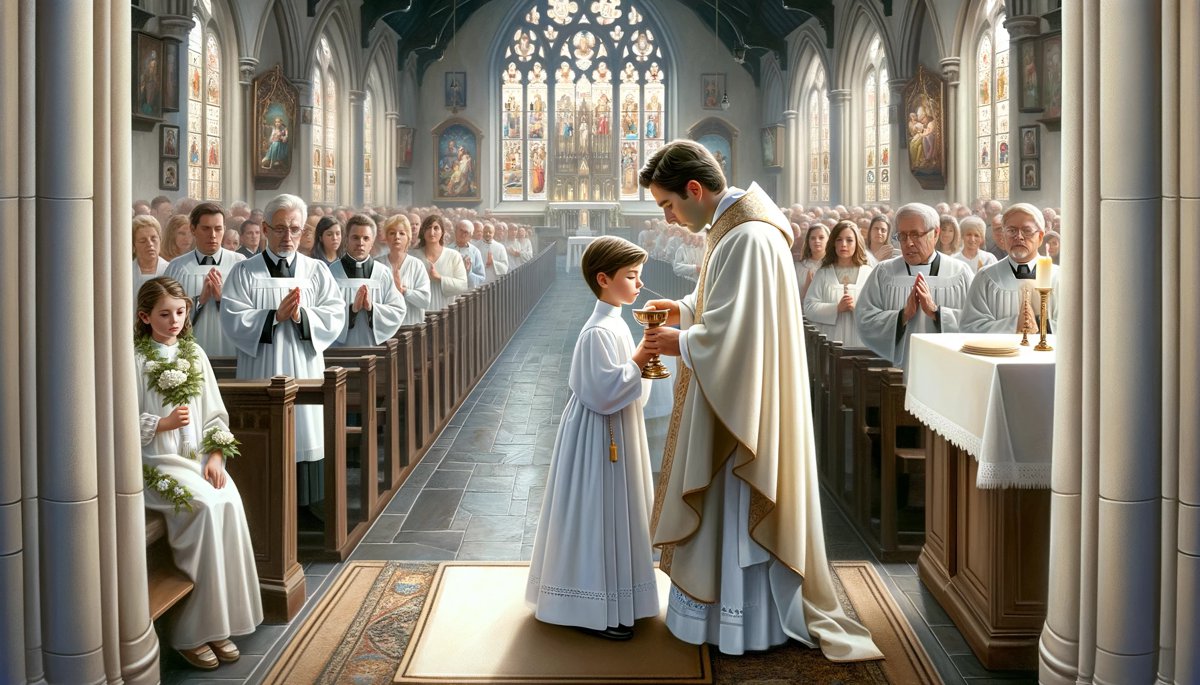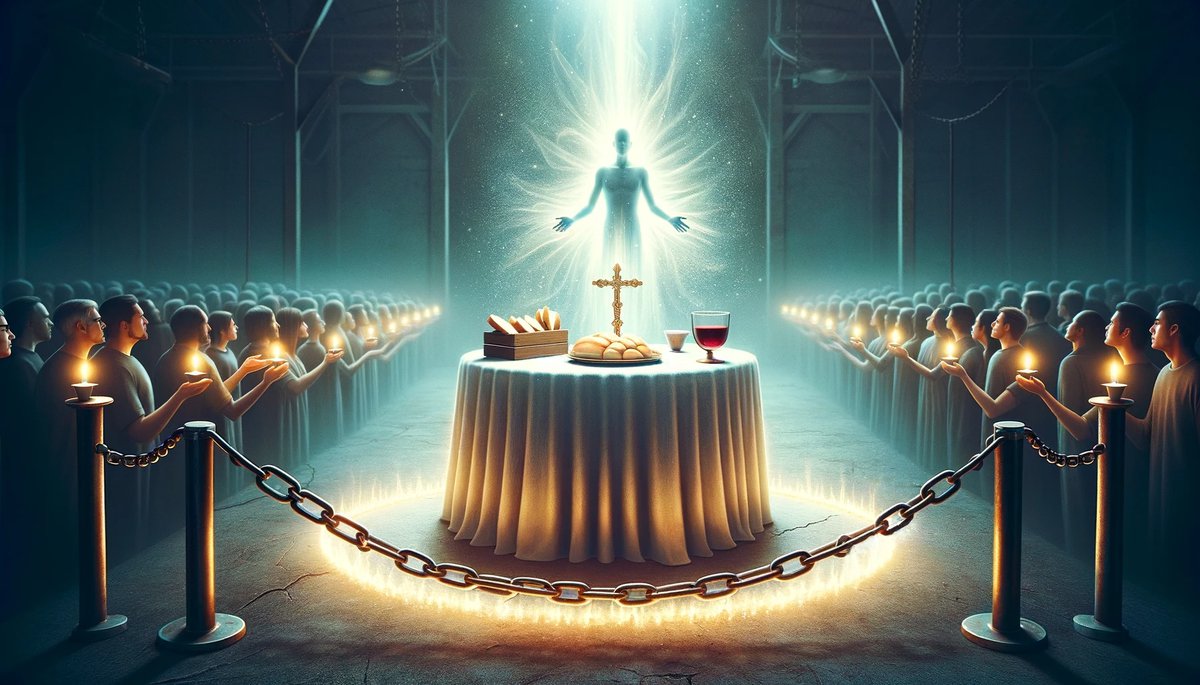Home>Theology and Spirituality>What Is Communion Wafer


Theology and Spirituality
What Is Communion Wafer
Published: February 19, 2024
Jason DeRose, Managing Editor at Christian.net, uses his expertise in religion and journalism to deepen understanding of faith's societal impacts. His editorial leadership, coupled with a strong academic background, enriches the platform’s diverse content, earning him recognition in both journalism and religious circles.
Learn about the significance and use of Communion wafers in theology and spirituality. Explore the traditions and practices surrounding this sacred element.
(Many of the links in this article redirect to a specific reviewed product. Your purchase of these products through affiliate links helps to generate commission for Christian.net, at no extra cost. Learn more)
Table of Contents
Introduction
Communion wafers, also known as altar bread or sacramental bread, hold a significant place in Christian religious practices, particularly within the context of the Eucharist. These thin, unleavened wafers play a pivotal role in the act of Holy Communion, symbolizing the body of Christ and serving as a sacred element of the Christian faith.
The history, ingredients, and production of communion wafers are deeply intertwined with the spiritual and cultural traditions of Christianity. Understanding the origins and significance of these wafers provides insight into their revered status within the faith. Additionally, exploring the controversies and variations surrounding communion wafers sheds light on the diverse interpretations and practices within different Christian denominations.
In this comprehensive exploration, we delve into the multifaceted aspects of communion wafers, from their historical roots to their modern-day significance. By examining the intricate details of their composition, the spiritual symbolism they embody, and the controversies they have sparked, we aim to provide a nuanced understanding of the profound role communion wafers play in the religious lives of millions of Christians worldwide.
Read more: What Is The Wafer Of Communion Made From
History of Communion Wafers
The history of communion wafers can be traced back to the early traditions of the Christian Church. The practice of using unleavened bread in religious ceremonies has its origins in the Jewish Passover, which Jesus and his disciples were celebrating at the Last Supper. During this significant event, Jesus broke bread and shared it with his disciples, instructing them to partake of it in remembrance of him. This act laid the foundation for the Christian ritual of Holy Communion, where bread symbolizes the body of Christ.
In the early Christian era, the use of unleavened bread for the Eucharist became standardized, reflecting the influence of Jewish customs and the scriptural accounts of the Last Supper. The precise evolution of the communion wafer as a thin, round disc is not definitively documented, but historical records indicate that by the Middle Ages, the practice of using small, unleavened wafers for the Eucharist had become widespread within the Western Church.
During the medieval period, the production and distribution of communion wafers were regulated by the Church, and specialized artisans known as "waferers" were responsible for crafting these sacred elements. The wafers were often stamped with religious symbols or designs, signifying their sanctity and adherence to specific religious standards.
The Protestant Reformation brought about variations in the use of communion wafers, with some reformers advocating for the use of ordinary bread or alternatives to the traditional unleavened wafers. However, the Roman Catholic Church and various Orthodox Christian traditions continued to uphold the practice of using unleavened communion wafers, emphasizing their theological significance and historical continuity with the early Christian Church.
Over time, the history of communion wafers has been shaped by cultural, theological, and liturgical developments, reflecting the diverse expressions of Christian worship and the enduring legacy of the Eucharistic tradition. Today, communion wafers remain a central element of the sacrament of Holy Communion, embodying centuries of religious heritage and spiritual symbolism within the Christian faith.
Ingredients of Communion Wafers
The ingredients of communion wafers are minimalistic, reflecting the symbolic purity and simplicity associated with the Eucharistic elements. Traditionally, communion wafers are made from wheat flour and water, with the exclusion of any leavening agents such as yeast or baking powder. This uncomplicated recipe aligns with the historical use of unleavened bread in religious rituals, harkening back to the Jewish Passover and the Last Supper of Jesus.
The use of wheat flour holds theological significance, as it symbolizes the sustenance and nourishment provided by Christ's body to the faithful. In addition to its symbolic representation, the choice of wheat flour also aligns with the historical context of the Near East, where wheat was a staple crop and held cultural importance.
The strict adherence to using only water and wheat flour underscores the sacred nature of communion wafers, emphasizing their role as a conduit for the spiritual communion with Christ. The absence of additives or flavorings serves to maintain the purity and integrity of the sacramental bread, ensuring that it remains a solemn symbol of Christ's body in the Eucharistic celebration.
In some traditions, particularly within the Roman Catholic Church, the preparation of communion wafers involves meticulous attention to detail and adherence to specific guidelines set forth by ecclesiastical authorities. The process often includes the baking of the wafers in a manner that ensures their uniformity, thinness, and consistency, reflecting the reverence and solemnity with which these elements are regarded.
While the basic ingredients of communion wafers remain consistent across denominations, variations may exist in the specific methods of preparation and the inclusion of additional ceremonial rituals associated with their consecration. These variations reflect the diverse theological interpretations and liturgical practices within different Christian traditions, underscoring the rich tapestry of beliefs and customs that characterize the broader Christian faith.
In essence, the ingredients of communion wafers encapsulate the profound spiritual symbolism and historical continuity of the Eucharistic tradition, embodying the enduring legacy of the Last Supper and the central role of the sacrament of Holy Communion in Christian worship.
Significance of Communion Wafers in Christianity
The significance of communion wafers in Christianity is deeply rooted in the theological understanding of the Eucharist as a sacred sacrament that embodies the spiritual presence of Christ. Central to Christian belief is the concept of transubstantiation, particularly emphasized in the Roman Catholic and Orthodox traditions, where the communion wafers are believed to undergo a profound transformation during the Eucharistic liturgy. According to this doctrine, the bread and wine consecrated during the Mass are transformed into the actual body and blood of Christ, while retaining the outward appearance of bread and wine.
This theological understanding underscores the profound significance of communion wafers as vessels of divine presence and spiritual nourishment. When partaking of the communion wafers, believers enter into a profound communion with the person of Christ, experiencing a tangible connection to the salvific sacrifice of Jesus on the cross. The act of consuming the communion wafers is imbued with profound symbolism, representing the incorporation of Christ's presence into the lives of the faithful and the unity of believers within the body of Christ.
Furthermore, the communal aspect of sharing the communion wafers underscores the unity and fellowship of the Christian community. As believers partake of the Eucharist together, they express their shared faith and participation in the life of the Church. The communion wafers serve as a unifying symbol, transcending individual differences and uniting believers in their shared devotion to Christ and the Gospel message.
In addition to its theological and communal significance, communion wafers hold a deeply personal and spiritual meaning for individual worshippers. The act of receiving the communion wafers is often accompanied by profound reverence and introspection, as believers contemplate the sacrificial love of Christ and the transformative power of the Eucharist in their lives. For many Christians, the communion wafers represent a tangible encounter with the divine, offering spiritual sustenance, healing, and renewal to the soul.
Overall, the significance of communion wafers in Christianity encompasses a rich tapestry of theological, communal, and personal dimensions, reflecting the central role of the Eucharist in the spiritual life of believers. As a sacred symbol of Christ's presence and a catalyst for spiritual communion, the communion wafers stand as a testament to the enduring significance of the Eucharistic tradition within the Christian faith.
How Communion Wafers are Made
The meticulous process of crafting communion wafers involves a blend of tradition, precision, and reverence, reflecting the sacred nature of these elements within the Christian faith. While the specific methods may vary across denominations and religious communities, the fundamental steps involved in the production of communion wafers adhere to time-honored practices that emphasize the sanctity and purity of these sacred elements.
The production of communion wafers typically begins with the careful selection of high-quality wheat flour, chosen for its purity and symbolic significance within the Eucharistic tradition. The flour is combined with water to form a simple, unleavened dough, adhering to the traditional recipe that mirrors the elemental simplicity of the bread used by Jesus at the Last Supper.
Once the dough is prepared, it is meticulously rolled out to achieve a uniform thickness, ensuring that the communion wafers possess the characteristic thinness that has become synonymous with these sacred elements. The use of specialized rolling pins and molds may be employed to achieve the desired shape and size, with great attention given to precision and consistency in the production process.
Following the shaping of the dough, the communion wafers are carefully perforated to create the distinct pattern of small holes, which serves both liturgical and practical purposes. These perforations allow for the easy breaking of the wafers during the Eucharistic celebration, facilitating the distribution of the sacred elements to the congregation.
The next stage involves the baking of the communion wafers in ovens specially designated for this sacred purpose. The baking process is conducted with meticulous care, ensuring that the wafers are uniformly cooked to achieve the desired texture and appearance. The resulting communion wafers exhibit a delicate crispness and a pale, golden hue, signifying their readiness for use in the Eucharistic liturgy.
Throughout the entire production process, from the initial preparation of the dough to the final baking of the wafers, a spirit of reverence and solemnity permeates the craftsmanship, underscoring the sacred nature of these elements. The artisans responsible for creating communion wafers approach their work with a sense of devotion, recognizing the profound significance of these wafers as vessels of Christ's presence in the Eucharistic celebration.
In essence, the production of communion wafers embodies a harmonious blend of tradition, craftsmanship, and spiritual devotion, culminating in the creation of sacred elements that hold profound significance within the Christian faith. The meticulous care and reverence invested in the making of communion wafers reflect the enduring legacy of the Eucharistic tradition and its central place in the spiritual lives of believers.
Read more: Who Makes The Communion Wafers
Different Types of Communion Wafers
Within the diverse tapestry of Christian traditions, various types of communion wafers are utilized, each reflecting unique theological emphases, cultural practices, and liturgical customs. While the fundamental essence of these wafers as symbols of Christ's body remains consistent, the specific variations in their composition, appearance, and usage offer insight into the rich diversity of Christian worship and sacramental observance.
-
Unleavened Communion Wafers: This traditional type of communion wafer, made from unleavened wheat flour and water, is widely used in Roman Catholic, Eastern Orthodox, and some Protestant denominations. These wafers adhere closely to the historical precedent of unleavened bread used in the Last Supper and emphasize the purity and simplicity of the Eucharistic elements.
-
Low-Gluten or Gluten-Free Wafers: In response to the dietary needs of individuals with gluten intolerance or celiac disease, some Christian communities offer low-gluten or gluten-free communion wafers. These wafers enable individuals with gluten sensitivities to participate fully in the Eucharistic celebration while accommodating their dietary restrictions.
-
Intinction Bread: In certain Christian traditions, particularly within the Eastern Orthodox Church, small cubes of leavened bread are used for the practice of intinction, where the bread is dipped into the consecrated wine before being consumed. While not technically wafers, these cubes of bread hold a distinct place in the Eucharistic ritual, offering an alternative form of receiving the body and blood of Christ.
-
Personalized Wafers: Some religious communities and monastic orders craft personalized communion wafers, often adorned with intricate designs, religious symbols, or inscriptions. These personalized wafers may be used in specific liturgical contexts or as a means of expressing the unique identity and spiritual heritage of a particular religious community.
-
Seasonal or Festive Wafers: During certain liturgical seasons or festive occasions within the Christian calendar, specialized communion wafers may be employed to reflect the thematic significance of the celebration. For example, during the Easter season, wafers adorned with symbols of resurrection and new life may be utilized, adding a layer of visual symbolism to the Eucharistic observance.
These diverse types of communion wafers exemplify the adaptability and richness of the Eucharistic tradition within Christianity, accommodating the varied needs and expressions of worship across different denominations and cultural contexts. While the core symbolism of the communion wafer as the body of Christ remains constant, the nuanced variations in their form and composition reflect the multifaceted nature of Christian sacramental practice and the enduring vitality of the Eucharistic tradition.
Controversies Surrounding Communion Wafers
The use and treatment of communion wafers have been a source of controversy and debate within the Christian community, giving rise to theological, liturgical, and ethical discussions that reflect the diverse perspectives and practices across different denominations. One of the enduring controversies pertains to the nature of the communion wafers and the theological understanding of their significance in the Eucharistic celebration.
Central to this controversy is the doctrine of transubstantiation, particularly emphasized in the Roman Catholic and Orthodox traditions, which asserts that the communion wafers undergo a substantial change, becoming the actual body of Christ while retaining the outward appearance of bread. This belief has been a point of contention, with some Christian denominations holding differing views on the nature of the Eucharistic elements, leading to theological disagreements and doctrinal divisions.
Another contentious issue revolves around the handling and distribution of communion wafers during the Eucharistic liturgy. Debates have arisen regarding the appropriate manner in which the wafers should be administered to the faithful, with considerations given to practices such as intinction (dipping the wafer in wine) versus the direct consumption of the consecrated bread. These discussions reflect differing interpretations of ancient liturgical customs and the theological implications of the modes of receiving the Eucharistic elements.
Furthermore, the controversies surrounding communion wafers extend to questions of inclusivity and accommodation within the Christian community. The introduction of low-gluten or gluten-free wafers to accommodate individuals with gluten sensitivities has sparked debates regarding the adherence to traditional liturgical norms versus the need to ensure the full participation of all believers in the Eucharistic celebration. These discussions intersect with broader ethical considerations related to accessibility and diversity within religious practices.
In addition, the production and sourcing of communion wafers have been the subject of ethical scrutiny, particularly concerning the use of fair trade ingredients and sustainable practices. Some Christian communities have raised concerns about the ethical implications of the supply chain for communion wafers, prompting reflections on the social justice dimensions of sacramental elements and their alignment with Christian values.
Overall, the controversies surrounding communion wafers underscore the dynamic and evolving nature of Christian sacramental theology and practice. These debates reflect the ongoing dialogue within the Christian community, encompassing theological, liturgical, ethical, and social dimensions that contribute to the rich tapestry of beliefs and practices within the broader Christian faith.
Conclusion
In conclusion, the exploration of communion wafers unveils a profound tapestry of historical, theological, and cultural significance within the Christian tradition. From their ancient origins rooted in the Last Supper to their enduring role as symbols of Christ's presence in the Eucharistic celebration, communion wafers encapsulate the rich heritage and spiritual depth of the Christian faith.
The history of communion wafers reflects the continuity of sacred traditions and the diverse expressions of Christian worship across different epochs and cultural landscapes. The evolution of these wafers from simple unleavened bread to meticulously crafted elements of the Eucharistic liturgy mirrors the enduring legacy of the Last Supper and the central place of the Eucharist in Christian communal life.
The theological significance of communion wafers as vessels of Christ's presence and the communal symbol of unity and fellowship underscores their profound impact on the spiritual lives of believers. The act of partaking of the communion wafers represents a tangible connection to the salvific sacrifice of Jesus and serves as a catalyst for communal devotion and shared faith within the body of Christ.
Furthermore, the controversies surrounding communion wafers highlight the dynamic nature of Christian sacramental theology and the ongoing dialogue within the Christian community. These debates encompass theological, liturgical, ethical, and social dimensions, reflecting the diverse perspectives and practices across different denominations and cultural contexts.
In essence, the communion wafers stand as a testament to the enduring vitality of the Eucharistic tradition within the Christian faith. Their simplicity in ingredients, meticulous craftsmanship, and profound symbolism serve as a unifying force that transcends denominational boundaries and cultural differences, uniting believers in their shared devotion to Christ and the Gospel message.
As communion wafers continue to hold a central place in the spiritual lives of millions of Christians worldwide, their significance as sacred elements of the Eucharistic celebration remains an enduring testament to the enduring legacy of the Last Supper and the transformative power of the Eucharist in the lives of believers.














